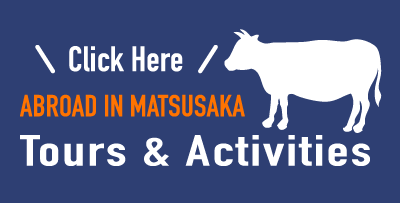
♦What is "Matsusaka cotton"?
Matsusaka cotton is a traditional craft of the Matsusaka area. Cotton threads are dyed with natural indigo and woven into patterns of neat vertical stripes. The four differently colored threads are produced by dyeing each a certain number of times, and these are combined to create a variety of striped patterns. In the past, the women of Matsusaka wove fabric at home in the farming off-season and sold it to help with household expenses. Even today some people continue the tradition of weaving by hand, and visitors to the Matsusaka Cotton Center can weave some fabric themselves with the help of an expert.

♦Try Matsusaka cotton #1 "kimono"
To really understand its appeal, we recommend trying on a kimono made from Matsusaka cotton while you explore the city center. The kimonos available for rent are specially designed to be easy to wear. It only takes 5 minutes to put on, and can be worn over your clothes. Plus, you'll get sandals, socks, and a pouch to hold your valuables. Once your outfit is complete, you're ready to take in the historical city sights or taste some Matsusaka cuisine. Since the indigo of the kimono complements any skin color, you'll look better than ever in the photos you take to remember this experience.
Note: There are no children's sizes. We have a selection of shoe and kimono sizes for men and women, but please contact us if you have questions about extra-large sizes. You may choose your kimono pattern among the available sizes. We recommend wearing a shirt with a V neck or low neck that won't be visible under the kimono. Please place an order on our website.
https://www.matsusaka-kanko.com/tour/en/

♦Try Matsusaka cotton #2 "hand-weaving"
Are you curious how Matsusaka cotton is woven? At the Matsusaka Cotton Center, you can even learn how to operate a traditional loom to make a piece of the fabric yourself. The hardest part—setting the loom with threads—is taken care of, so you can enjoy the rhythmic activity as you pedal, push, and tap to assemble the cloth line by line. At first, it may be difficult, but soon you'll be absorbed in it and lose track of time.
Choose the course that fits your schedule.
Mini course: 1 hour, including instructions. Make a 15 x 20 cm piece of fabric. 1,300 yen per person (maximum of 4 people). Available from 9 AM to 3 PM.
Half-day course: 4 to 5 hours. Make a 1 meter length of fabric. 6,000 yen per person (maximum of 2 people).
Note: Selection of fabric pattern is limited. Because the preparation takes a long time, each of the four looms is set beforehand with threads. Thus, you are able to choose a pattern from among the unoccupied looms.
You must be 145cm or taller, and be able to sit in the loom chair. You may not participate if you are pregnant or under the influence of alcohol.
Reservations must be made at least 3 days in advance. Please place an order on our website.
https://www.matsusaka-kanko.com/tour/en/
♦History
In the Edo period (17th to 19th century), Matsusaka cotton became a very popular fabric for kimonos. At that time, ordinary people were not allowed to wear extravagant clothes made of silk or with flashy designs. Merchants from Matsusaka opened stores in the capital, Edo (now called Tokyo), and started selling the cotton fabric made in their hometown. They called it "Matsusaka cotton," and it was a hit. People loved the soft, warm cotton and fashionable indigo stripes. Because Matsusaka cotton uses fine stripes and subtle colors, at a distance it tends to look like a plain fabric and does not attract attention. However, the pattern becomes clearly visible when one approaches. This appealed to the Edo citizens' sense of sophistication. There is a rich variety of striped patterns, with over 50 types. Finding your favorite pattern of stripes is another appealing aspect of Matsusaka cotton. (At the Matsusaka Cotton Center, you can see an antique book of fabric samples from the Edo period.) When demand for Matsusaka cotton was at its highest, 500,000 kimonos worth of the fabric was being shipped every year to Edo, whose population was only one million. To put it another way, you could that say every one in two people in Edo was wearing Matsusaka cotton. Nowadays, most people in Tokyo are not familiar with Matsusaka cotton, but kabuki actors still refer to wearing a striped kimono as "wearing a Matsusaka."
Matsusaka cotton became very popular for a time, and a few merchants found huge success by selling it. Some prominent examples include the merchant families of Mitsui, Hasegawa, and Ozu. The Mitsui family is known worldwide for the Mitsukoshi department stores and Mitsui Group. In fact, Matsusaka Cotton Center is built on the spot where the Mitsui mansion used to stand . Also, the Birthplace of the Mitsui Family is located nearby, and can be seen from outside (though entry is prohibited). Plus, the Former Hasegawa Residence, a National Important Cultural Property, is close to the Matsusaka Cotton Center. Its mansion and its impressive gardens are open to visitors. Lastly, the Former Ozu Residence is also a short distance away, and can be entered.
The natural indigo-dyeing process is still being used today, and contributes to the quality of Matsusaka cotton. The threads range from white, light blue, navy and deep purple. This is because indigo dye builds up on the cotton fibers each time they are dyed. Indigo also strengthens the cotton and makes the fabric heavier. The CEO of Miitoori, the last manufacturer of Matsusaka cotton, says the appeal of the fabric is "the unique texture of the natural dyes, its classic color that looks better with each wash, and the fit that gets better the longer you wear it."
Did you find that you love Matsusaka cotton? The Matsusaka Cotton Center has many clothes and accessories for sale. Add some indigo stripes to your wardrobe, or pick out a unique souvenir for someone back home. Some customers report wearing our products for years and years with little wear. When you consider that indigo also has useful insect-repellant properties, what more could you ask for?
Matsusaka-shi Sangyo Shinko Center 1F
Hours: 9 AM to 5 PM. Closed on Tuesdays.
http://matsusakamomen.com/
Credit cards accepted























